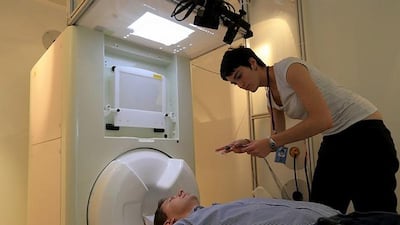ABU DHABI // Children who are bilingual must not only understand a second language to develop their skills, they need to use both languages.
That was one of the conclusions of researchers at NYU Abu Dhabi, whose study found that bilinguals used different parts of the brain while switching between languages for speaking and listening.
“If, as it seems, producing [speaking] and comprehending language switches relies on different brain mechanisms, we should make sure that both production and comprehension are sufficiently trained when teaching a second language,” said Esti Blanco-Elorrieta, a PhD psychology student at NYUAD and lead author of the study that was recently published in the Journal of Neuroscience.
Working at the neuroscience language lab on NYUAD’s Saadiyat Island campus, Ms Blanco-Elorrieta and her adviser, associate professor of linguistics and psychology Liina Pylkkanen, monitored bilingual speakers’ brain activity while they shifted from speaking and listening between Arabic and English, as well as while switching tasks.
Using a magneto-encephalography (MEG) machine, the researchers were able to see what regions of the subjects’ brains were active during which tasks. Their initial findings showed a link between the speaking and the task exercises when the prefrontal cortex – the front part of the brain responsible for thought analysis and abstract thinking – was active.
This was in line with the bilingual advantage hypothesis in which scientists believed that those fluent in more than one language had an advantage over monolinguals because being bilingual requires more cognitive control – problem-solving, memory and thought.
This gave bilinguals an advantage not only in the use of language, but also in performing any tasks requiring focus.
Although it is a now a more widely accepted theory, a contrary opinion was held by researchers in the first half of the 20th century when they thought bilingualism hurt a child’s IQ and verbal development. Some sceptics of the bilingual advantage still say that benefits for dual-language speakers would only exist if the same control networks in the brain were used for both language and non-language tasks.
“It’s a big question in the field of language cognition, whether there is something special about language switching and language control that’s particular to language, or whether the same brain machinery is applied for both language and non-language switching and control,” said Ms Blanco-Elorrieta.
It was during the listening portion of the experiments, however, that the researchers found the most intriguing results.
When subjects were exposed to two different languages the researchers found that a different area of the brain, the anterior cingulate cortex, was engaged.
“These findings show that different parts of the brain are used for switching between languages in speaking and listening, which is a novel finding because no one has done this kind of comparison before,” said Ms Blanco-Elorrieta.
This led them to claim that if an advantage of being bilingual did exist the benefits would only apply to productive tasks, and not to ones of perception.
The PhD student said that Abu Dhabi was a “fantastic place to do this kind of research, because there are so many people who speak a variety of languages”.
tsubaihi@thenational.ae

